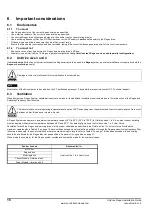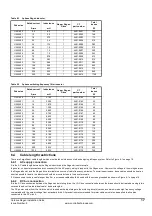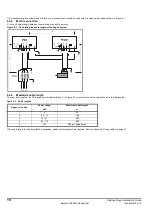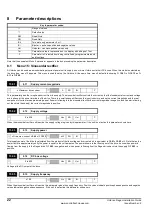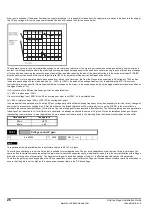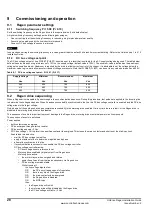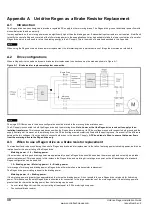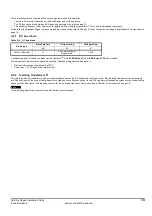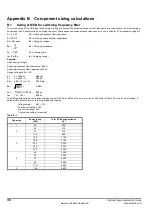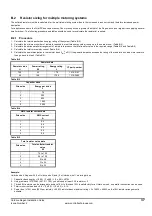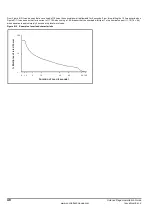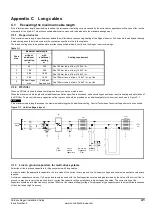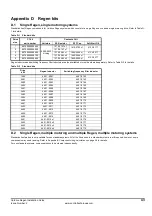
28
Unidrive Regen Installation Guide
www.controltechniques.com
Issue Number: 2
9
Commissioning and operation
9.1
Regen parameter settings
9.1.1
Switching frequency Pr 15.08 (Pr 0.18)
Set the switching frequency on the Regen drive to the required value (3kHz default value).
A higher switching frequency setting has the following advantages:
•
Line current ripple at the switching frequency is reduced, giving improved waveform quality.
•
Acoustic noise produced by the line inductors is reduced.
•
Dynamic DC bus voltage response is improved.
N
In some cases, setting the switching frequency to a value greater than the default 3kHz results in current derating. Refer to the Unidrive size 1 to 4 / 5
Installation Guide.
9.1.2
DC bus voltage set point
The DC bus voltage set point, see Pr 15.07 (Pr 0.17), should be set to a level that is suitable for the AC supply voltage being used. The table below
defines these levels, assuming a tolerance of
±
10% on the supply voltage (default value is 700V). The minimum value is defined as the peak input
voltage plus some headroom. Headroom is required by the drive to allow correct control of the current. It is advisable to set the voltage below the
maximum value to give more allowance for transient voltage overshoots. Note that Pr 15.07 (Pr 0.17) can be set to any value between 0 and 800V.
Table 9-1
DC bus voltage set point - Pr 15.07 (Pr 0.17)
9.2
Regen drive sequencing
When a Regen drive is enabled, it goes through a line synchronisation sequence. During this procedure, test pulses are applied to the incoming line
to determine the voltage and phase. When it has been successfully synchronised to the line, the DC bus voltage controller is enabled and the DC bus
voltage rises to the target voltage.
Only when all of these stages have been completed successfully is the motoring drive enabled. If at any time there is a fault, or the Regen drive is
disabled, the motoring drive will also be disabled.
This sequence of events is important to prevent damage to the Regen drive, motoring drive or external power circuit components.
The sequence of events is as follows:
Power applied:
•
both contactors de-energised
•
DC bus charges through start-up resistor
•
DC bus voltage equals
√
2 Vac
•
if DC bus voltage > UU trip level then auxiliary contactor is energised. This closes the main contactor and shorts out the start-up circuit.
Enable input made active:
•
wait for DC bus voltage to stabilise
•
apply test pulses to line to determine magnitude and phase
•
attempt to synchronise to the line
•
if synchronisation is successful then enable the DC bus voltage controller
DC bus voltage controller active:
•
DC bus voltage rises to reference level
•
Motoring drive enabled by digital output from Regen drive
Motoring drive active:
•
the motor may now be energised and rotated
•
power flows to and from the line as necessary via Regen drive
•
DC bus voltage remains stable
Whilst running if:
the line voltage dips too low
OR
the DC bus voltage goes out of regulation
OR
there is any trip on the Regen drive
OR
the main contactor is de-energised
OR
the Regen drive is disabled
OR
the MCB trips
then:
•
the Regen drive will inhibit
•
the motoring drive will be disabled by the Regen drive
•
the DC bus voltage will fall to
√
2 Vac
Supply Voltage
Minimum
Recommended
Maximum
Vac
Vdc
Vdc
Vdc
380
650
700
800
415
680
700
800
480
780
780
800
NOTE



